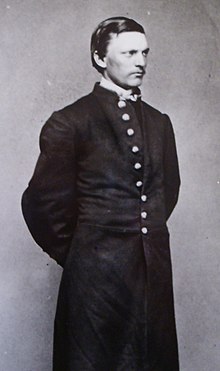Washington Roebling
| Washington Roebling | |
|---|---|

Washington Augustus Roebling (1837-1926)
|
|
| Born |
Washington Augustus Roebling May 26, 1837 Saxonburg, Pennsylvania, USA |
| Died | July 21, 1926 (aged 89) Trenton, New Jersey, USA |
| Engineering career | |
| Projects | Allegheny Bridge, Cincinnati-Covington Bridge, Brooklyn Bridge |
Washington Augustus Roebling (May 26, 1837 – July 21, 1926) was an American civil engineer best known for supervising the construction of the Brooklyn Bridge, which was initially designed by his father John A. Roebling.
The oldest son of John Roebling, Washington was born in Saxonburg, Pennsylvania, a town co-founded by his father and his uncle, Carl Roebling. His early schooling consisted of tutoring by Riedel and under Henne in Pittsburgh. He was also sent to stay with Professor Lemuel Stephens of the Western University of Pennsylvania (now known as the University of Pittsburgh) where Roebling also attended some classes. He eventually attended the Trenton Academy and acquired further education at the Rensselaer Polytechnic Institute in Troy, New York, from 1854 to 1857, where he wrote a thesis titled "Design for a Suspension Aqueduct." Following his graduation as civil engineer (C.E.), he joined his father to work as a bridge builder. From 1858 to 1860, he assisted his father on the Allegheny Bridge project, living in a boarding house on Penn Street. Following the completion of the bridge, he returned to Trenton to work in his father's wire mill.
On April 16, 1861, during the American Civil War, Roebling enlisted as a private in the New Jersey Militia. Seeking more than garrison duty, he resigned after two months and re-enlisted in a New York artillery battery, 2nd Lieut. Company K, 83rd NY Volunteers performing staff duty engaged in the erection of suspension bridges. He rose steadily in rank and was soon commissioned as an officer.
Roebling saw action in numerous battles: Manassas Junction (Second Bull Run), Antietam, Chancellorsville, the Wilderness, Siege of Petersburg, and most notably Gettysburg. Soon after Chancellorsville, he was perhaps the first to note the movement of Robert E. Lee's Confederate Army toward the northwest while conducting air balloon reconnaissance.
...
Wikipedia
